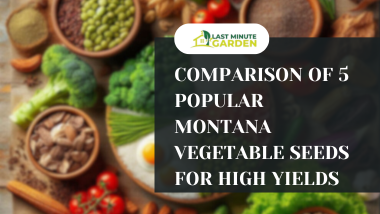Unlock your garden’s potential with Montana vegetable seeds that promise impressive yields and resilience in the diverse Montana climate
Selecting the right vegetable seeds for your farm is essential to achieving a productive harvest. In Montana, where the climate can be unpredictable, choosing seeds that can thrive in these unique conditions is even more critical.
Understanding which Montana vegetable seeds are ideal in Montana for maximum harvests while you’re gardening for yourself or as a business can provide you with a competitive advantage.
This guide provides a thorough comparison of five popular seed varieties, helping you make informed decisions that will maximize your crop’s potential.
1. Montana Heirloom Tomato Seeds: A Classic Choice for Flavor and Yield
When it comes to tomatoes, heirloom varieties are a favorite among Montana growers. Known for their robust flavor and adaptability, these seeds consistently deliver high yields. Heirloom tomatoes thrive in Montana’s shorter growing season, making them a popular choice for both small-scale gardeners and commercial farmers alike.
Yield Potential: Heirloom tomatoes can produce up to 25 pounds of fruit per plant under optimal conditions. With Montana’s warm summers, these plants benefit from the right balance of sunshine and cooler evenings, which helps them mature and ripen perfectly.
Best Practices: To ensure high yields, start your Montana vegetable seeds indoors at least six to eight weeks before the last frost date. Once the weather stabilizes, transplant them outdoors in nutrient-rich soil for best results. Regular watering and staking are essential for healthy growth.
2. Sugar Snap Peas: A High-Yield Crop for Early Planting
Sugar snap peas are another excellent addition to any Montana vegetable garden. Known for their crisp texture and sweet flavor, sugar snap peas offer early-season harvests, making them ideal for Montana’s variable spring weather.
Yield Potential: This variety of peas can yield up to 3 pounds per 10-foot row, making them a reliable choice for high returns on a relatively small amount of space. Their vertical growth habit also helps maximize garden space, which is particularly useful for small-scale farming.
Best Practices: Plant your sugar snap peas as soon as the soil is workable in early spring. These Montana vegetable seeds prefer cool soil and perform best when sown directly outdoors. Ensure they receive full sun and provide them with a trellis or other support system for climbing.
3. Montana-Bred Carrot Seeds: Root Vegetables for Maximum Yield
Carrots are one of the hardest vegetables, and Montana-bred varieties are no exception. These Montana vegetable seeds are specifically developed to handle colder temperatures and produce exceptional yields, even in the state’s less-than-ideal soil conditions.
Yield Potential: Carrots can yield between 5 and 6 pounds per square foot when grown under ideal conditions. Their deep roots thrive in Montana’s loose, well-drained soil, and they tend to grow larger and sweeter in cooler climates.
Best Practices: For high yields, plant your carrot seeds in rows with ample spacing. These Montana vegetable seeds should be sown directly in the soil after the danger of frost has passed. Water consistently to maintain even soil moisture, and ensure your carrots have enough room to grow without overcrowding.
4. Montana Spinach Seeds: A Cold-Tolerant Green for Continuous Harvests
Spinach is a cold-hardy green that excels in Montana’s cooler spring and fall seasons. It’s an ideal choice for farmers seeking a reliable and fast-growing crop that delivers throughout the growing season. These Montana vegetable seeds can handle light frosts, extending your harvesting window significantly.
Yield Potential: Spinach can yield between 1.5 and 2 pounds per square foot, depending on the variety and growing conditions. Continuous harvesting by picking outer leaves allows for prolonged production, making spinach an incredibly efficient crop.
Best Practices: Sow spinach seeds directly into the soil as soon as it’s workable in early spring. These Montana vegetable seeds thrive in full sun to partial shade. Regular harvesting of mature leaves encourages new growth, ensuring a steady supply throughout the season.
5. Montana Sweet Corn Seeds: A Warm-Season Crop for High Yields
Sweet corn is a staple in Montana’s vegetable farms due to its adaptability and high yield potential. When selecting corn varieties, Montana vegetable seeds bred for shorter growing seasons offer the best chance of success in the state’s climate. Sweet corn requires consistent warmth and a long growing season, making it ideal for planting in late spring after the last frost.
Yield Potential: A typical sweet corn plant can yield 2 to 3 ears per stalk, with rows yielding up to 20 ears per 10-foot row. This makes sweet corn a highly productive crop, perfect for larger garden plots or commercial farms.
Best Practices: Plant sweet corn seeds in blocks rather than single rows to ensure proper pollination. These Montana vegetable seeds need full sun and fertile, well-drained soil. Consistent watering, especially during the tasseling and ear development stages, is essential for maximizing yield.
Final Thoughts: Maximizing Your Yield with the Right Montana Vegetable Seeds
Choosing the right Montana vegetable seeds is the key to achieving a high-yield harvest, regardless of the scale of your farm. Each of the varieties discussed here—heirloom tomatoes, sugar snap peas, Montana-bred carrots, spinach, and sweet corn—offers unique advantages that cater to Montana’s specific growing conditions.
Understanding the strengths of these seed types and implementing best practices in planting and care will allow you to optimize your yields season after season.
If you’re managing a commercial operation or cultivating a backyard garden, investing in high-quality Montana vegetable seeds is an investment in your farm’s success. Keep these tips in mind as you plan your next planting, and watch your harvest thrive.
Let’s get connected as you get more insight about gardening!





